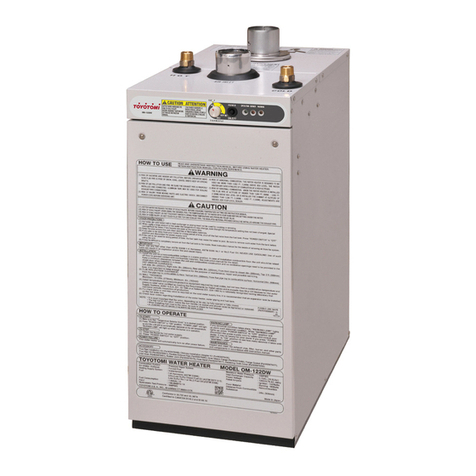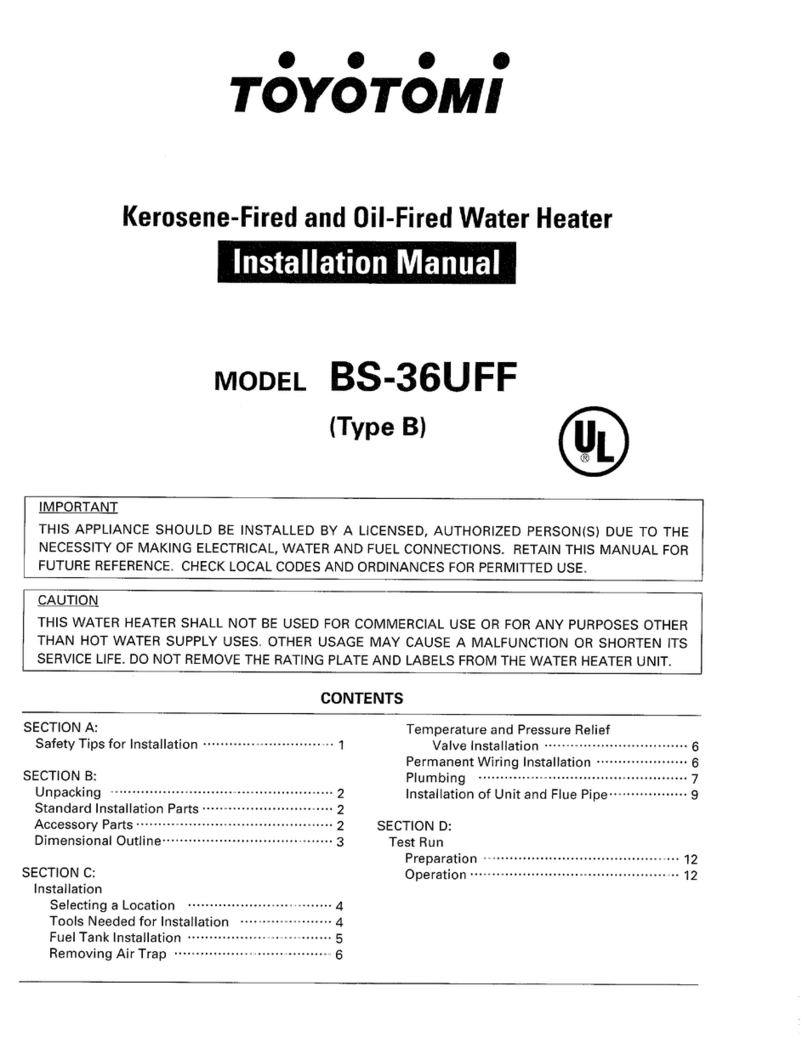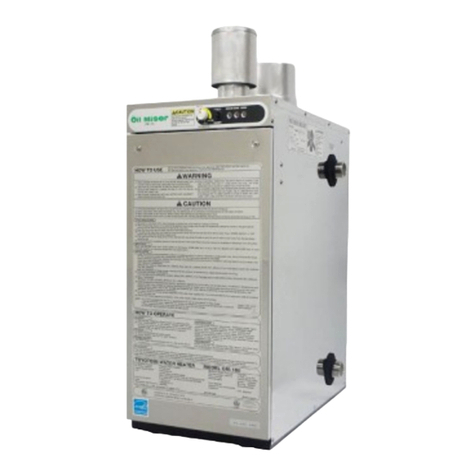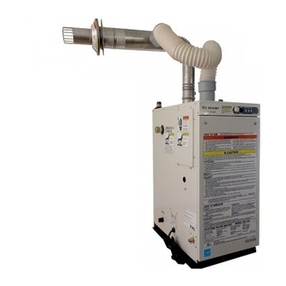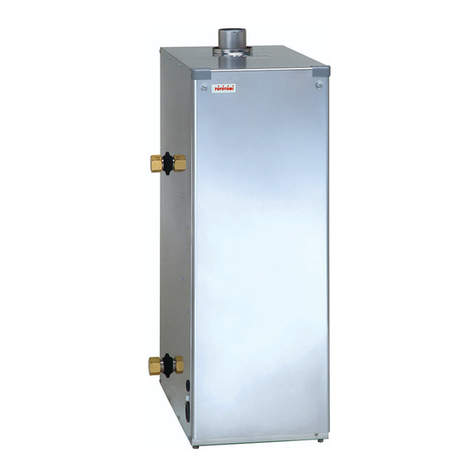
PLUMBING
WARNING: Plumbing should conform to proper plumbing methods, and in conformance with local codes
or regulations.
A licensed plumber familiar with local codes and ordinances should install the OM-180.
CAUTION: An ANSI (AMERICAN NATIONAL STANDARD INSTITUTE) listed temperature and pressure
relief valve should be installed at the hot water outlet connection of the heater at the time of
installation. Local codes should govern the installation of the relief devices.
If a check valve or one-way valve is required on the cold water supply line, it is recommended
that an expansion tank (100 psi, 8 gal. Min.) should be installed on the hot water supply line.
When the unit is to be installed as a replacement water heater, it is important to determine
whether a check valve has been installed or not.
Remove the check valve before installation of the unit unless a check valve is required by local code.
In order to prevent the water heater from being damaged or develop-
ing a leak, regardless of being used in a cold, warm or hot region, the
cold water supply piping, hot water supply piping, drain pipe, check
valve, valves, expansion tank, and temperature and pressure relief
valve should be protected with sufficient insulation materials to pre-
vent freezing (by wrapping with heat insulation or by equipping with a
freeze prevention heater).
Do not use a smaller pipe for connection at the hot water outlet. Using
a smaller pipe for connection will cause a greater air layer in the top of
the heat exchanger not allowing water to cover the temperature sensor.
Install a pipe as shown in the diagram when using a smaller pipe.
COLD AND HOT WATER PLUMBING
1.
A water softener is recommended in regions where hard water may be a concern.
2. Use the following water quality.
3. Do not apply any heat to the unit fittings.
4. Use standard copper alloy unions and fittings for the connections to the unit.
5. Copper piping is recommended for the hot water supply line.
Note: Refer to local codes when considering piping materials. Steel piping is not recommended as it
may cause rust in the piping. Use NPT (NATION PIPE THREAD) for piping of hot and cold water.
6.
Connecting plumbing to the unit, hold unit fittings securely with a wrench to prevent damage to the unit.
7. Installation of a water strainer and the air release valve is recommended.
8.
The distance between the water heater and places where the hot water is used should be as short and direct as
possible, and a uniform pipe size of sufficient diameter to carry the full capacity of hot water should be used.
9. Be sure to connect the water inlet and the hot water outlet as shown on the water heater. Reversing the
two connections will damage the unit.
10. When hot water flows through the supply line there is an inevitable heat loss, regardless of type of
water heater. Thus, insulation or protection of hot water piping is encouraged.
11. Flush the piping before connecting to the unit.
HEATING SYSTEM PLUMBING
NOTE: Select a place where the heating piping for the water heater and end convector can shortened as
much as possible.
NOTE: Make sure the piping for the convector is laid-out properly, and also check for leakage with a pres-
sure test.
NOTE: Circulation pump capacity should be selected in accordance with the water head loss caused by the
required maximum flow and the longest piping.
7
Hot water
outlet Change to a
smaller pipe here
Air release
valve
Tee
Description pH Chloride Hardness Residual Chlorine
Maximum Levels 6.5 to 8.5 0.0067 Oz/gal.
(50 mg/L)
0.0208 Oz/gal.
(150 mg/L)
0.00027 Oz/gal.
(2 mg/L)
OM-180(in/E) 11.5.24 1:16 PM ページ 7
8
1. Install heat insulation material on the hot water piping to prevent heat loss.
2. In closed systems we recommend the use of an antifreege solution to prevent freezing and corrosion.
Check with the plumbing installer for the proper mix.
3.
Copper or stainless steel or cross-linked polyethylene pipe should be used for the main and branch pipes.
4. Be sure to connect a hot water pipe with the Expansion Tank, and install at the inlet side of the
Circulation Pump.
5. Install an Air Separator and Air Release Valve in the hot water pipe to release air inside of the pipe.
6. Be sure to install a bypass circuit. (Closing the hot water pipe with a thermal valve or temperature con-
trol valve may cause problems in the Circulation Pump.)
7. Be sure to install unions in the inlet and outlet sides for easy connections and/or removal.
8. Be sure to install a pressure relief valve on the intake side of the circulation pump used for the heating
piping. Set the pressure relief valve pressure to correspond to the capacity of the expansion tank. See
the items related to setting the pressure relief valve pressure and selection of the expansion tank con-
cerning the capacity of the closed expansion tank.
Selecting an Expansion Tank
Select an expansion tank by referring to the following calculation formula and the calculation formulas pro-
vided by the manufacturers of tanks sold commercially.
Supplying water to and releasing air from the heating piping.
1. When supplying water to the heating piping, close the valve 1,
then open the heating piping’s drain valve and supply valve and
fill the piping with water.
Let the supply water pressure be lower than the set pressure on
the pressure relief valve.
2. Close the drain valve when circulating water starts to come out
of the drain outlet, then open the air release valve in the heating
piping and release the air out of the piping.
3. Open the valve 1and run the circulation pumps, circulating water through the piping while releasing
the air out. The air will be efficiently released from the pipes if the air is released from the heating piping
once with each circuit of the water in the piping.
4. After circulating water through the piping for approximately 10 minutes, close the supply water valve,
then close the air release valve.
Expansion Tank Calculation Formula
Vo(gal)=
Water heater’s heat exchanger volume + convector capacity + piping holding capacity (See the table below).
Water holding
capacity per
foot of copper
pipe.
1/4
0.0040
3/8
0.0083
1/2
0.0133
3/4
0.0269
1
0.0455
1-1/4
0.0680
1-1/2
0.0953
P2+14.5
P2-P1
V=+
1.1 V0V
Vo
P1
P2
:
:
:
:
:
Tank Capacity of Expansion Tank (gal)
Total volume of heating piping system (gal)
Expansion coefficient of water
Expansion tank’s gas charge pressure (PSI)
Set a gas charge pressure that is the maximum static pressure brought to
bear on the expansion tank (the pressure drop between the expansion tank
and the convector) with 1.45~2.9 PSI added.
Pressure Relief Valve Set Pressure (PSI)
Water holding
capacity per
foot of tap
water line.
Nominal diameter (in.)
Holding capacity (gal/ft)
Nominal diameter (in.)
Holding capacity (gal/ft)
Expansion
coefficient of
Water
176˚F (80˚C)
0.0291
1/2
0.0161
3/4
0.0298
1
0.0483
1-1/4
0.0886
1-1/2
0.1095
Temperature
Coefficient of Expansion
Valve1
Water
Heater
Side Convertor
Supply
Water
Valve
Supply
Water
Drain
Water
Drain
Valve
OM-180(in/E) 11.5.24 1:16 PM ページ 8
OM-180-K.indd 8 12/07/13 14:55


